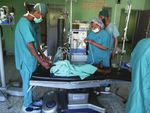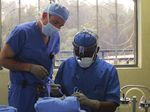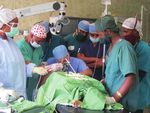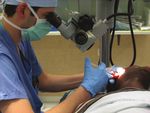Developing Pediatric Otolaryngology in Sub-Saharan Africa - Healing the Children's Experience in Ethiopia
←
→
Page content transcription
If your browser does not render page correctly, please read the page content below
Developing Pediatric Otolaryngology
in Sub-Saharan Africa - Healing the Children’s
Experience in Ethiopia
Glenn Isaacson and Margaretha L. Casselbrant
Stage I – Helping the children
Healing the Children’s involvement in Ethiopia began with a picture.
Desma Ferrell, Executive Director of Healing the Children’s Philadelphia
branch, had visited Ethiopia and found a pediatric ward in Addis Ababa, Ethiopia,
filled with sad looking children (Figure 1). Each of them had a tracheotomy. She
wanted to find a way to help these children and let them eventually go home.
Figure 1. Pediatric ward in Addis Ababa, Ethiopia
She contacted medical colleagues on her return to Philadelphia with this
goal in mind. Thus began the first of 15 semi-annual short-term missions to the
horn of Africa.
The original intent was to help these particular children. When the team of
nurses, anesthesiologists, and pediatric otolaryngologists arrived, they realized
that the problem was not lack of equipment or knowledge of a particular surgical
technique, but absent infrastructure – not just medical infrastructure, but national
infrastructure.1 These children had recurrent respiratory papillomatosis not sub-
glottic stenosis. Their hospital had a microscope, microdebrider and a skilled sur-
geon to care for them. They could not go home because there was no electricity to
run a suction pump.2
Stage 2 – Helping the residency
Ethiopia is the second largest nation in Africa by population with more
than 96 million people – half of them children. Realizing that an one-off medical
mission would not make a dent, Healing the Children’s team decided to focus
on improving quality and capacity of care in Pediatric Otolaryngology and An-
esthesiology.74 ! XV IAPO MANUAL OF PEDIATRIC OTORHINOLARYNGOLOGY
With the help of a US-trained expatriate Ethiopian pediatrician, the team was
introduced to the existing otolaryngologists and anesthesiologists in the country.
There were about a dozen of each, mostly located in the capital city of Addis Aba-
ba. There were newly created residencies for otolaryngology and anesthesiology.
Working with these existing programs, Healing the Children focused first on pa-
tient care and education.
Surgeries (Figures 2, 3 and 4) were done initially at government hospitals
including Tikur Anbessa (Black Lion Hospital), the premier teaching institution in
the country. The facilities were in bad repair having been constructed by the Swed-
ish in the 1950s and maintained poorly under the recent communist government.
It was difficult to do more than one or two operations in a day. This limited the
potential for both education and patient care.
Fortunately, Healing the Children was
introduced to another non-governmental
organization (NGO) working in Ethiopia.
CURE-International had just built a small spe-
cialty hospital following an American model.
Though spartan, it was adequately staffed and
equipped for orthopedic and plastic surgery.
This proved a more productive site for pediat-
ric surgery and resident education.
In the first five years of recurring sur-
Figure 2. Sugery gical missions, Healing the Children was
able to educate the first classes of Addis
Ababa University otolaryngology residents
in soft tissue technique, endoscopy, and
otology. This was done through a combina-
tion of didactic lectures, simulation labora-
tories using cadaver dissection and animal
models, and clinic and OR teaching. The
focus was on information transfer rather
than volume surgery.3
During the same period, Healing
Figure 3. Sugery the Children also developed a relationship
with the Makanissa School for the Deaf.
(Figure 5) Team physicians and audiolo-
gists cared for children with profound hear-
ing loss at this total-communication school
providing hearing aids where appropriate
and medical care including tympanoplasty
for those children with partial hearing losses.
Eventually, the first class of AAU Oto-
laryngology graduates was sent off to re-
gional hospitals throughout Ethiopia to prac-
Figure 4. Sugery tice their trade (Figure 6).XV IAPO MANUAL OF PEDIATRIC OTORHINOLARYNGOLOGY ! 75
Stage 3 – Assessing impact
While the first years were
productive in terms of patient care
and basic otolaryngology educa-
tion, there were obvious problems.
The team was only in Ethiopia two
weeks out of the year. This was in-
adequate for good continuing pa-
tient care and for education. Even-
tually, the Healing the Children
team learned by word-of-mouth
about other NGO teams visiting
Figure 5. Makanissa School for the Deaf
Ethiopia. We began to coordinate
our activities, working together,
sharing missions and resources, and
developing a curriculum for residen-
cy education. Eventually, by sharing
donated resources, we were able to
put together the first temporal bone
laboratory in the horn of Africa and
to teach several courses using cadaver
temporal bones.
In this third phase of develop-
ment, it was important to stop and
think about whether we were doing
the right thing. Clearly, transmission of
information to the Ethiopian Otolaryn-
Figure 6. Otolaryngology graduates practicing gology residents was a good thing to
do. We participated in their Board ex-
aminations at the completion of the four-year residency. The students were bright
and had learned much. However, while their information bases were good, there
were clearly major deficiencies in surgical skills. We needed to do more.
We also wanted to know whether the surgeries we were doing produced
good outcomes. As our first collaborative research project with AAU, we re-
viewed the pre- and post-operative audiograms and surgical results of all of our
tympanoplasties. The results were comparable to those reported by developing
world surgical programs, though they would have been considered inadequate in
Europe or the United States.4
Stage 4 – Helping the graduates – growing capacity
Our most recent efforts have been focused on the graduates of the AAU
residency. Several of them were assigned to regional hospitals. They tried to prac-
tice Otolaryngology and failed. They lacked local support, equipment, and con-
fidence in their surgical skills. To correct these deficiencies, we helped them find
postgraduate fellowship training both at sites in Africa, and in the United States.
Through the American Academy of Otolaryngology’s visiting scholar program,76 ! XV IAPO MANUAL OF PEDIATRIC OTORHINOLARYNGOLOGY
AAU graduates attended the AAO-HNS national meeting and did mini-fellow-
ships at Temple University, University of Pennsylvania, SUNY-Syracuse, and
Harvard hospitals. Graduates have participated in Head and Neck fellowships in
Kenya, Spain, and Senegal.
The lack of surgical instruments and operating microscopes was particularly
acute. Healing the Children worked in coordination with several US hospitals and
NGOs to find decommissioned instruments and transport them to Ethiopia. It was
possible to rehabilitate discarded operating microscopes using alternative power
sources and LED lighting. Boeing Corporation and Ethiopian Airlines provided
transportation for these heavy items on newly purchased commercial airliners.
The Healing the Children teams vis-
ited the hospitals and universities around
Ethiopia where the AAU graduates
were stationed. We worked with them to
help improve their operating room flow
(Figure 7). Our audiologists trained
Ethiopian nurses to do hearing tests. We
operated together with the graduates on
difficult cases at their home hospitals and
at CURE-Ethiopia to help them develop
Figure 7. Sugery confidence in their surgical skills.
Healing the Children has moved
from the surgical mission model to a newer paradigm. It focuses on transfer of
knowledge and technology to Ethiopian physicians. It is hoped that with con-
tinuing support, a new generation of otolaryngologists will address the huge
need for surgical care in this populous developing country.
Stage 5 – Developing research skills
Healing the Children faculty have worked in coordination with Ethiopian
universities and the AAU graduates to develop research skills.
While caring for the treated HIV+ children at Mother Teresa School, it had
been noticed that many of the children had chronic ear infections with perfora-
tions with/without drainage and hearing loss. Therefore, it was decided to perform
a study to assess the prevalence of ear disease and to what degree the hearing
loss was conductive, sensorineu-
ral or mixed in these children and
compare the findings with those
obtained in a normal population of
similar age school children from
Birhaneh Zare Elementary School
(Figures 8 and 9).
IRB approval of the study
was obtained from AAU, Temple
University, Philadelphia as well as
University of Pittsburgh. The study
team consisted of Drs. Mekula (Ad- Figure 8. Performing otoscopyXV IAPO MANUAL OF PEDIATRIC OTORHINOLARYNGOLOGY ! 77
dis Ababa), Isaacson, Ensink (Neth-
erlands) and Casselbrant as well as
6 audiologists, 2 medical students,
residents and a medical assistant
who also helped with translation.
Approval had been had been ob-
tained from the schools administra-
tion. Written consent was obtained
from parents. The principals and
teachers at the two schools were
Figure 9. Hearing test very supportive.
Prior to examination each
child was informed about the evaluations and written assent was obtained from
each child. An ear examination using a pneumatic otoscopy was performed by
the otolaryngologists and hearing testing was then done by the audiologists.
Any child with a draining ear was treated with ear drops and was to be seen at
CURE-Ethiopia, but team members for follow up. For children with severe hear-
ing loss, a simple hearing aid was provided. 113 children at Mother Teresa School
were tested in the fall of 2015 and 204 children from Birhanen Zare Elementary
School were tested in the spring of 2016. The data collected are presently being
processed and analyzed.
Our next project is to study the causes of sensorineural hearing loss in pro-
foundly deaf children and their siblings at the Makanissa School for the Deaf.
References
1 Isaacson G, Drum ET, Cohen MS. Surgical missions to developing countries: Ethical con-
flicts. Otolaryngol Head Neck Surg. 2010 Oct;143(4):476-9
2 Isaacson G, Buchinsky FJ. More than a surgical mission--pediatric Otolaryngolo-
gy in Ethiopia. Int J Pediatr Otorhinolaryngol. 2011 Aug;75(8):1018-9. doi: 10.1016/j.
ijporl.2011.05.007.
3 Isaacson G. Framework for advancing otolaryngology: head and neck surgery in Ethiopia.
Otolaryngol Head Neck Surg. 2014 Oct;151(4):634-7. doi:10.1177/0194599814542591.
4 Isaacson G, Melaku A. Results of pediatric tympanoplasty on short-term surgical missions.
Laryngoscope. 2016 Jun;126(6):1464-9.You can also read


























































